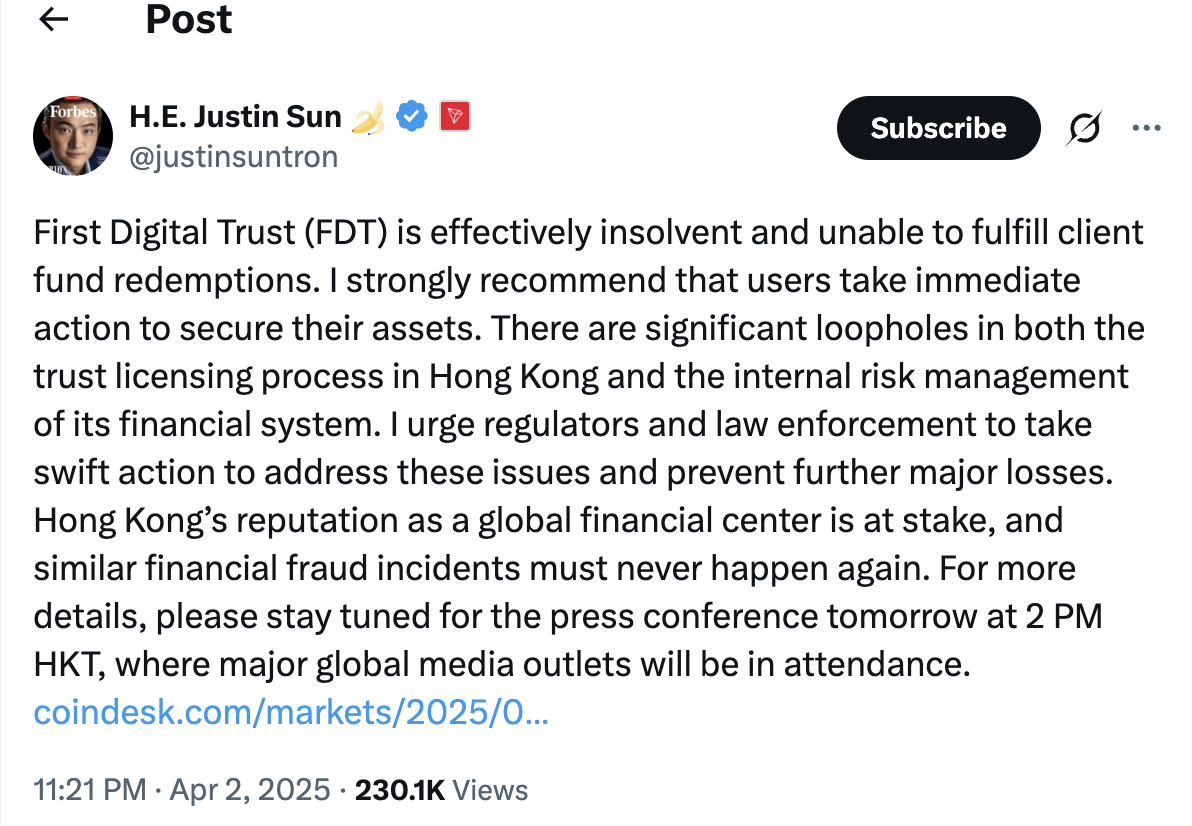Source: Cointelegraph Original: "{title}"
Incident Overview:
FDUSD is the sixth largest stablecoin, with a market capitalization of nearly $2.4 billion. On Wednesday (April 2), the price of the coin experienced a severe de-pegging, dropping to as low as $0.76. Although its price has now returned to the pegged level, FDUSD's market capitalization has still shrunk.
The reason behind this—Tron founder Justin Sun's tweet.
On Wednesday night, Justin Sun suddenly attacked the issuer of FDUSD, First Digital Trust, on social media platform X, stating that this Hong Kong-based company "is actually insolvent and unable to fulfill customer redemption requests."
In response to Sun's accusations, First Digital immediately rebutted, condemning it as Sun's "smear" campaign and emphasizing that FDUSD "is fully solvent," and the company will "take legal action to protect its rights and reputation."

An hour later, Justin Sun tweeted again, reiterating that his claim about First Digital Trust's insolvency is a "fact-based statement."
According to First Digital's latest reserve report for February 2025, the total reserves held by the company at that time amounted to $2.051 billion, while the total issued FDUSD was 2.042 billion tokens.
Like most centralized stablecoins, First Digital Trust's collateral assets are primarily composed of U.S. Treasury bonds, overnight time deposits, and U.S. dollar cash. Although third-party verification reports have some reference value, stablecoins still struggle to escape the risks of trust and counterparty.
The rapid rise of FDUSD is closely tied to the strategic support from Binance. In 2023, due to regulatory pressure, Binance was forced to terminate support for its own stablecoin BUSD (Binance USD), and at that time, FDUSD was launched as a timely alternative to maintain liquidity in the Binance ecosystem. At the launch of FDUSD, Binance also introduced six zero-fee trading pairs for FDUSD spot and leveraged trading, and subsequently, FDUSD was highly integrated into the Binance ecosystem.
Market data shows that as of April 2, 2025, FDUSD's total market capitalization was approximately $2.5 billion, with Binance holding about 94% of the circulating supply, equivalent to approximately $2.35 billion.
On the morning of April 3, Binance, as the largest backer of FDUSD, released its audit report seven hours after the incident began to unfold. The report stated: "As of the report recording time, March 1, 2025, at 9 AM (UTC+8), the reserve amount for FDUSD was $2,051,348,188.70, held entirely in the form of U.S. Treasury bonds and overnight time deposits. This reserve size exceeds the total circulating amount of FDUSD at the time of the audit, ensuring that holders can redeem at a 1:1 ratio for U.S. dollars."
After the incident, First Digital Labs urgently destroyed 87 million FDUSD tokens in an attempt to stabilize market confidence. Wintermute also purchased over 31 million FDUSD tokens from Binance. Blockchain data monitoring platform Lookonchain stated: "Assuming they bought the stablecoin when FDUSD dropped to around $0.90, they would earn over $3 million when FDUSD returns to its peg."
Although these measures alleviated some of the pressure on FDUSD, they still struggled to restore investor trust.
Justin Sun has also filed a lawsuit against First Digital Trust, accusing it of misappropriating nearly $500 million of customer funds.
Past Records of Stablecoin De-pegging:
The de-pegging incident of FDUSD reveals several key issues in the stablecoin market regarding market confidence, stablecoin reserves, and transparency. The value of stablecoins heavily relies on market trust in their issuers and reserve assets. In the cryptocurrency field, the rapid dissemination of information and statements from public figures can also have a significant impact on the market. From past records, stablecoins have not been immune to de-pegging incidents.
In the past three years, here are the three major de-pegging records:
May 2022: TerraUSD (UST) De-pegging
Incident Overview: The algorithmic stablecoin UST of the Terra ecosystem decoupled from the U.S. dollar, leading to a rapid decline in its value.
Impact: UST and its associated token LUNA nearly went to zero, triggering widespread market panic and a chain reaction that caused significant losses for multiple crypto projects and companies.
Aftermath: Terra founder Do Kwon was wanted by multiple countries for fraud.
March 2023: USD Coin (USDC) and DAI De-pegging
Incident Overview: Due to the collapse of Silicon Valley Bank (SVB), part of USDC's reserve funds were blocked, causing the price of USDC to drop to as low as $0.877.
October 2023: Real USD (USDR) De-pegging
Incident Overview: USDR decoupled from the U.S. dollar due to insufficient liquidity and asset structure issues amid a surge in redemption requests.
What Should Be the "Gold Standard" for Stablecoin Stability?
William Campbell, the consulting director at USDKG, pointed out in a previous opinion piece that for thousands of years, gold has been the ultimate store of value for humanity. By directly linking digital tokens to physical gold, the speculative risks of cryptocurrencies and the inflation risks of government-issued currencies can be avoided. Blockchain technology, by enabling partial digital ownership and intermediary-free global transactions, eliminates the traditional barriers to gold ownership.
In addition, Campbell also stated that the main challenge facing stablecoins is building user trust. This trust cannot be based solely on the company's reputation. It must be earned through independently verifiable collateral, real-time audits, and clear regulatory oversight.
免责声明:本文章仅代表作者个人观点,不代表本平台的立场和观点。本文章仅供信息分享,不构成对任何人的任何投资建议。用户与作者之间的任何争议,与本平台无关。如网页中刊载的文章或图片涉及侵权,请提供相关的权利证明和身份证明发送邮件到support@aicoin.com,本平台相关工作人员将会进行核查。




